Compilation: Archini Nayak
Choodi Pooja
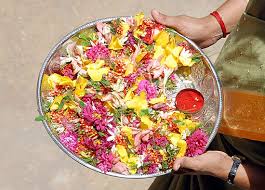
This is a festival to celebrate and worship the sun god and nature. All married GSB ladies celebrate this Pooja on the Sundays of this month every year. This Pooja is done to satisfy the sun god and all nature.
The Pooja is done in every home and then choodi is offered to all women in community. The choodi is prepared with different plants and flowers. Everyone uses different plants in their choodis, so there is variety of design. All the plants used are said to have medicinal values. Some people prepare some sweets for naivedya (offering). The choodis are worshipped with incense and aarti. Then they are poured with akshta and pray to gods. The choodi is offered to Tulsi, Sun god, the coconut tree, water well, and the front door. After the Pooja the choodi is offered to elders and other married women in the community.
Anantha Chaturdasi
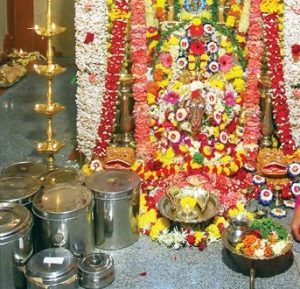
This is a festival that takes place around September 27, and is at the end of Vinayaka Chaturthi. This was the Pooja recommended by Krishna to the Pandavas while they were on their vanavasa.
Vrata is observed on the chathurdasi day falling in shuklapaksha in the month of Bhaadrapath. This Pooja is mainly performed in the temples because of the strictness of the Pooja. The temple is decorated with bunches of coconut, banana trees, garlands of mango leaves and varieties of fruits. The coconut is also hung in the temple by the GSB community. Every household carries one coconut for the Pooja. This Pooja is done to ensure good crops. A pot holding a coconut is decorated with great serpent Adhishesha, the seat of reclining Lord Vishnu, and a thread with 14 knots. This invokes the Lord’s presence and then the Pooja is performed with naivedya of sweets and fruits. The thread is kept in safety until the next Anantha Chathurdashi and then immersed in a holy river.
Vinayaka Chathurthi
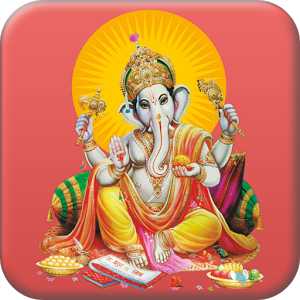
This festival takes place the week before Anantha Chathurdasi, and was recommended by Lord Krishna to the Pandvas before the Kurukshetra War.
It is performed by all Hindus to seek the welfare and prosperity of the loved ones. There are no detailed preparations for this Pooja, however, this Pooja is confined to being performed in temples. The day starts with a bath in sesame oil. The modak is prepared with jiggery as neivedhya. The Pooja is conducted by invoking Ganesh in a Kalash filled with grain, and topped with a coconut. This is decorated with small flowers and mango leaves. The décor inside the house is done with flowers, leaves, and kumkum. The prasadam is fruits flowers and other items. The moon should not be viewed on this day
Sri Krishna Janmashtami.
This festival is also called Gokulashtami, Janmashtami and Ashtami Rohini. This day celebrates Krishna, the eighth avatar of Vishnu. The Lord Krishna was born at midnight, on the eighth day of waning moon.
Fasting is observed during the day. The Pooja is done at midnight, Chanting of Vishnu Sahasranama, Ashtothara Pooja, and Neivedya Samarpanam is done. Food is served to all and Prasad is given. People who are fasting eat food only after viewing moonlight. Please abstain from rice on this day. The main neivedyam is prepared from soaked bengalgram, sugar cane pieces and small slices of fresh coconut. Banana halwa is also used.
Gouri Pooja (Vayana Pooja)
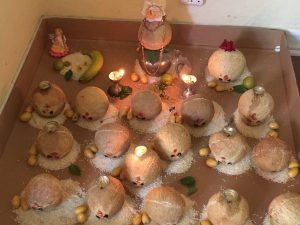
This is performed in Andhra Pradesh, Karnataka, and Maharashtra. It is performed for happy married life. It is observed on Tuesdays in July or August.
The house and Pooja area is cleaned, and the house is decorated with mango leaves. Kalash is filled with water and betel leaf is placed inside. Cloth is placed at back of kalasha. Decorate Goddess Gouri with kumkuma, turmeric, and flowers. Pray by offering flowers and incense. Prasdam is given to friends and family.
Yugadi
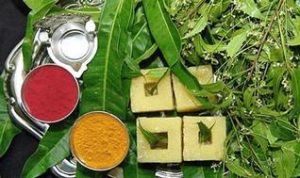
This is the New Year’s Day for the Telugu, Konkani and Kannada communities in India. Yugadi means “beginning of a new age” in Sanskrit. This festival is celebrated with great pomp and fanfare.
The preparations for the festival begin in advance. The house is cleaned, and new clothes are bought. Take shower and decorate the front of the house with mongo leaves. Prepare puliogure and hoilge as the special foods for the day. Yugadai pachadi is a dish associated with Yugadi. It is prepared with jaggery, raw mango, neem flowers, and tamarind. The six different tastes represent life, a mixture of different experiences. The new experiences of life should be accepted together with the New Year.
Deepavali
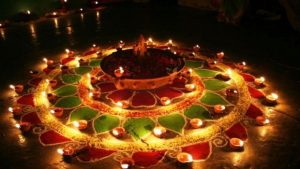
This is the festival that celebrates the triumph of good over evil, also called the festival of lights. It is celebrated in the fall, somewhere around the end of October and the beginning of November. The festival extends over a period of five days, but the main festival day falls on the new moon night. The festival celebrates the return of lord Rama returning home after defeating Ravana and 14 years of exile.
The festivities begin with giving the house a thorough cleaning. People buy gifts for family members, like sweets, appliances, kitchen utensils, and seasonal food. Stories are told about the many battles between good and evil, and patterned rangoli is drawn near doors and on walkways. On deepavali night, fireworks are burst in the sky and sparklers are enjoyed by all. After this, people return home to take an oil bath, and then return to attend the aarti.
